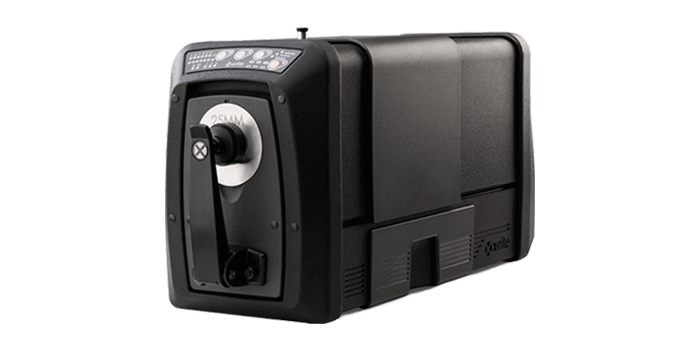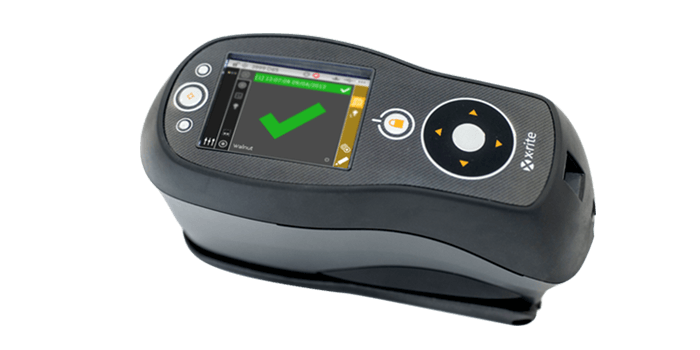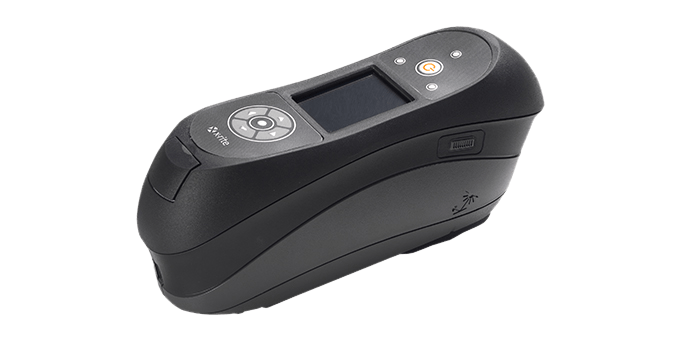Inter-instrument agreement is a very important consideration when selecting color measurement devices for your workflow. Unfortunately, it’s such a technical topic that it leads to a lot of confusion about what it means and why it’s important.

The Ci7860 sphere benchtop spectrophotomter is has an inter-instrument agreement specification of 0.06 average Delta E*, enabling brands to create the most precise master color standards.
Today we’re making it as simple as possible. Read on to learn what inter-instrument agreement means, how it’s different from other terms like inter-modal agreement and repeatability, and why it’s something you really need to consider for your color workflow.
- Inter-instrument agreement tells you how accurately two devices of the same make and model can repeat a color measurement. The key here is “make and model,” meaning you’re comparing measurements from two Ci64 sphere handhelds or two MA-T12 multi-angle spectrophotometers.
- Comparing how accurately two different instruments, such as the Ci64 and the MA-T12, can repeat a measurement is called inter-modal agreement.
- Then there’s repeatability. This indicates how accurately a single device can repeat a measurement. If you use the same device to measure the same sample three times, how closely will those three measurements correlate?
The Main Causes of Color Variation Across the Supply Chain
Within color measurement, there are certain factors that contribute to color variation across a supply chain.
Inter-Instrument Agreement
Here’s an example. The Ci7860 was specifically designed to minimize the contribution of inter-instrument variances to color error, ensuring the most accurate and consistent color control to create the most precise master color standards. It has a published average inter-instrument agreement of 0.06 ΔE*ab. That means if you take a measurement with a Ci7860, the result will be within +/- 0.06 ΔE tolerance from the centroid – the geometric center of the L*a*b* plane in the color space.
To get the centroid measurement, we create a master standard and send it to the National Institute of Standards (NIST) for traceability certification, then build the device around that exacting data.
Here is where a lot of the confusion lies.
- You take a measurement with one Ci7860 and the difference is +0.05 ΔE on the +b* side from centroid. This is acceptable.
- You take another measurement of the same sample with a different Ci7860, and the difference is -0.05 ΔE on the -b* side from centroid. This is also acceptable.
- However, when you compare the two measurements, they are actually .1 ΔE apart. That does not mean either device is out of tolerance. They are both measuring within the specified inter-instrument agreement.
Inter-Modal Agreement
Our customers run into even more issues when they’re using different devices in the same color workflow.
Think about the data coming out of the portable Ci64 handheld versus the more precise Ci7860. Because they work using different sphere diameters, sampling port sizes, detector arrays and light sources, it’s nearly impossible for them to read exactly alike.
That being said, we’ve done a lot of work to get to the closest possible inter-modal agreement among our devices. Our Ci6x series and SP series instruments are good examples. Even though they’re different instruments, they have pretty close inter-modal agreement.

Our Ci64 is our most precise handheld sphere spectrophotometer with a published average inter-instrument agreement of 0.13 ΔE*ab.
Why is this important?
If you work in a complex supply chain with multiple departments or different sites, you’re very familiar with the problem of color inconsistency. A lot of times, this inconsistency is caused by using different devices to specify, produce, and control color.
For example, if the brand owner uses the Ci7860 to specify a standard color, then the shop uses the Ci64 to verify production accuracy, you’re not comparing apples to apples. Multiply this by the number of different instruments that are used in the supply chain to produce each color, and you can continue to move farther and farther out of tolerance.
If you have inter-modal agreement, you can have multiple sites using a single digital standard. That’s where inter-instrument agreement is the most successful.
What can be done?
As you can imagine, you’re most likely to achieve the closest ΔE results using one instrument with good repeatability, but most supply chains need more than one device to work efficiently and effectively. Here are some tips for establishing the most accurate color workflow in a multi-instrument environment.
- As much as possible, use the same instruments across your supply chain and vendors.
- Ensure instrument repeatability. To do this, you need to calibrate frequently – we recommend daily but sometimes every eight hours is prudent. You should also send in your devices for scheduled maintenance/certification.
- Find common ground with shared physical standards. Even if you’re using two different instruments, comparing to the same standard when taking measurements will provide a measurable and comparable ΔE.

Did you know Munsell Color creates custom standards?
- If you’re straddling industries, such as manufacturing a plastic clamp to hold together a printed piece, you’re probably going to encounter instruments with different geometries. Ask for the same target data, or better yet, a physical sample to match. No matter which instrument you use, the ΔE from the target will be accurate.
- Add a solution like NetProfiler to optimize device performance and reduce variance between instruments. This easy-to-use-solution helps reduce costly errors due to measurement drift, identifies instruments in need of service, and helps to avoid inaccurate color in the production of products. Plus, if you’re managing a pool of different instruments, bringing them all closer to centroid helps them all read closer together.
The biggest benefit of inter-instrument agreement is the peace of mind that you can’t get any other way. When your measurements are reproducible and traceable, you can trust your instruments and work with confidence.
If you’re still confused, don’t worry. It’s a technical topic. Get in touch and we can help you find the best balance between repeatability, inter-modal agreement, and inter-instrument agreement for your color workflow needs.
Featured Color Management Solutions
Learn more about these featured products:

Ci7860
The Ci7860 benchtop spectrophotometer creates the industry’s most accurate digital color standards to better communicate color specifications to suppliers across the entire supply chain.
Ci64
The Ci64, X-Rite’s most precise handheld sphere spectrophotometer, is available in three models: with simultaneous SPIN/SPEX, correlated gloss, and a UV option.
